Sizing Up Servers: Intel's Skylake-SP Xeon versus AMD's EPYC 7000 - The Server CPU Battle of the Decade?
by Johan De Gelas & Ian Cutress on July 11, 2017 12:15 PM EST- Posted in
- CPUs
- AMD
- Intel
- Xeon
- Enterprise
- Skylake
- Zen
- Naples
- Skylake-SP
- EPYC
Intel’s Turbo Modes
A last minute detail from Intel yesterday was information on the Turbo modes. As expected, not all of the processors actually run at their rated/base frequency: most will apply a series of turbo modes depending on how many cores are registered as ‘active’. Each core can have its frequency adjusted independently, allowing VMs to take advantage of different workload types and not be hamstrung by occupants on other VMs in the same socket. This becomes important when AVX, AVX2 and AVX-512 are being used at the same time.
Most of the turbo modes are a sliding scale, with the peak turbo used when only one or two cores are active, sliding down to a minimum frequency that may be the ‘base’ frequency or just above it. There’s a lot of information for the parts here, so we’ll break it down into stages.
First up, a look at the Platinum 8180 in the different modes:
It should be worth noting what the base frequency actually is, and some of the nuance in Intel’s wording here. The base frequency is the guaranteed frequency of the chip – Intel sells the chip with the base frequencies as the guarantee, such that when the chip is not idle and not in normal conditions (i.e. when not in thermal power states to reduce temperature) should operate at this frequency or above it. Intel also lists the per-core turbo frequencies as ‘Maximum Core Frequencies’ indicating that the processors could be running lower than listed, depending on power distribution and requirements in other areas of the chip (such as the uncore, or memory controller). It’s a vague set of terms but ultimately the frequency is determined on the fly and can be affected by many factors, but Intel guarantees a certain amount and provides guides as to what it expects the turbo frequencies to be.
As for the Platinum 8180, it keeps its top turbo modes while up to two cores are active, and then drops down. It does this again for another two cores, and a further two cores. From this point, under non-AVX load the CPU is pretty much the same frequency until >20 cores are loaded, but does not decrease that much in all. For AVX 2.0 and AVX-512, the downward slope of more cores means less frequency continues, with AVX-512 taking a bigger jump down at 13 cores loaded. The final turbo frequency for AVX-512 running on all cores is 2.3 GHz.
Comparing the two 28-core CPUs for which we have turbo information gives this graph. The numbers relate to the number of cores need to be loaded for that frequency.
Both processors are equal to each other for dual core loading, but the separation occurs when more cores are loaded. As we move through to AVX 2.0 and AVX-512, it is clear where the separations are in performance – to get the best for variable core loading, the more expensive processors are required.
Here’s the big table for all the processors on Non-AVX loading:
Despite the 2.0/2.1 GHz base on most of the Platinum series, all the CPUs will turbo up to 3.7-3.8 GHz on low core loading except for the lower power Platinum 8153. For users wanting to strike a good balance between the core count and frequency, the Gold 6154 is probably the place to be: 18 cores that will only ever run at 3.7 GHz with non-AVX loading (3.5-2.7 GHz on AVX-512 depending on core count), and will be $3543 as a list price at 205W. It is perhaps worth noting that this will likely top any of the Core i9 processors planned: at 18-cores and 205W for 3.7 GHz, the Core i9-7980XE which will have 18 cores but run 165W will likely be clocked lower (but also only ~$2000).
Moving onto AVX2.0 and AVX-512:


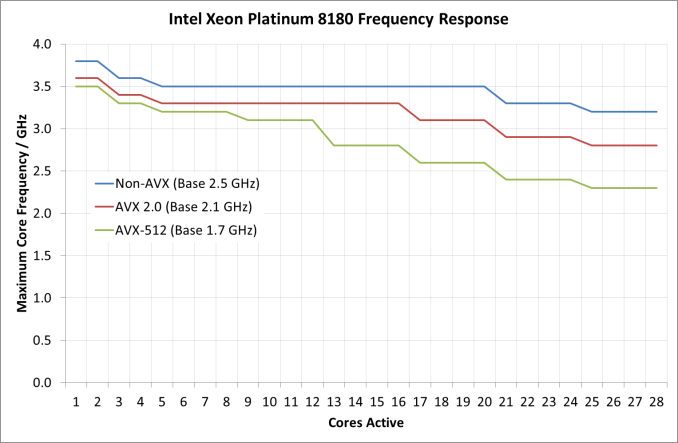
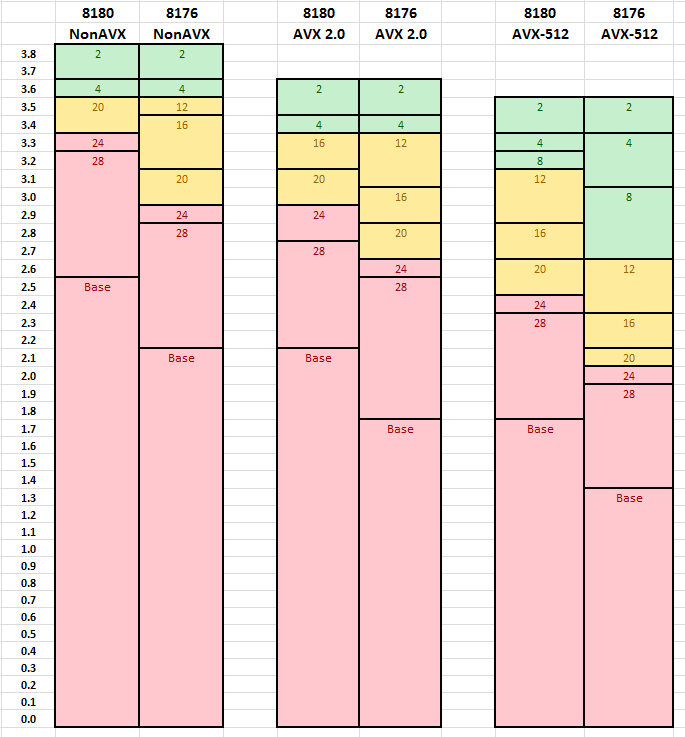
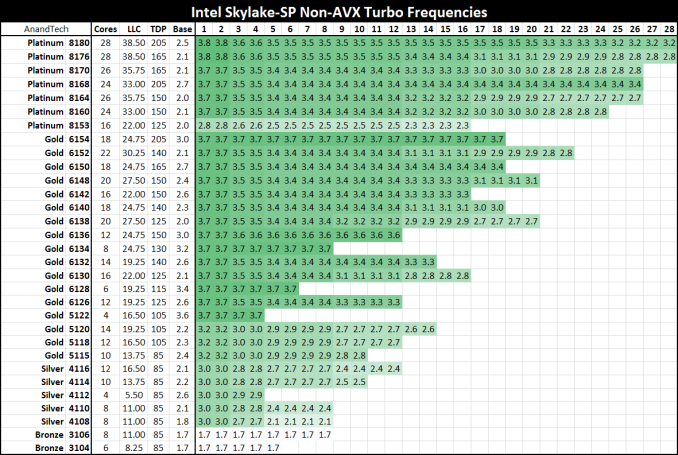
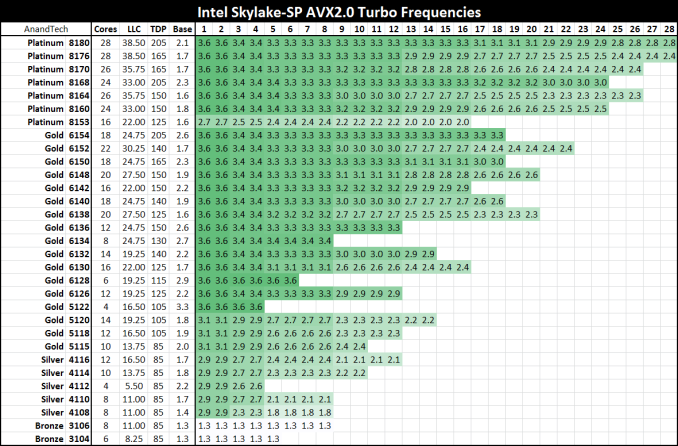
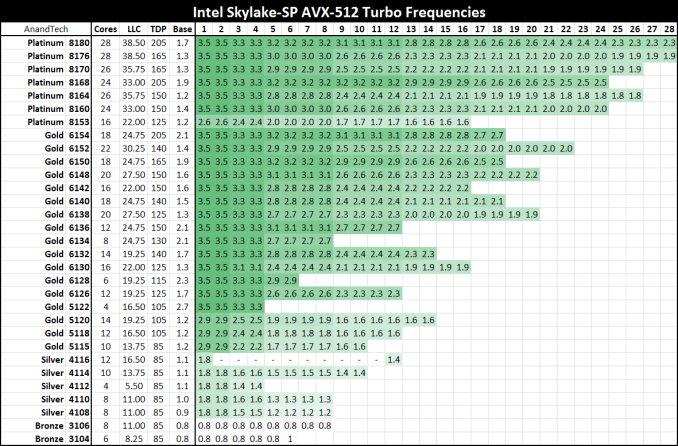








219 Comments
View All Comments
sharath.naik - Wednesday, July 12, 2017 - link
http://www.anandtech.com/show/10158/the-intel-xeon...Here is the link for you a single Xeon E5 v4 22 core does 5.3 (Dual at 5.9)jobs a day compared to dual Epyc 6.3. Ok they are 7% apart for dual socket but only 15% faster for dual epyc compared to single Xeon E5. Big Data does not do well in NUMA set up, same is the case with any regular large data applications. Try running EPYC without splitting spark into multiple processes, you will see how terrible a dual EPYC is going to be (the review mentions it but does not give a graph). Now this is terrible, to use EPYC first you need to change the way you build and run the applications and then expect 7-15% advantage vs a 2000$ CPU. It simple shows that EPYC is only use full for VMs and some synthetic tests. Any applications that deal with data can and should stay away from EPYC
warreo - Friday, July 14, 2017 - link
Why are you comparing Spark 1.5 benchmarks against 2.1.1? Johan pointed out in the article why they are not comparable and why he is using the new 2.1.1 benchmark.The exact Dual Xeon E5 2699 v4 you are referencing that did 5.9 jobs per day in Spark 1.5 only does 4.9 jobs per day on Spark 2.1.1. If we assume a similar % gap between dual and single as it was in Spark 1.5, then a single Xeon E5 2699 v4 would be capable of only 4.4 jobs per day in Spark 2.1.1, which is a 43% difference compared to dual Epycs.
Even leaving that aside, your exact arguments can be applied to the new Xeons as well, which are only 5% faster than the Epycs. Do you think the new Xeons suck as well?
Same thing for splitting Spark into multiple processes and needing to re-write applications -- you also run into the exact same issue with the new Xeons (which Johan also explictly points out).
Based on your arguments, I'm confused why you are taking aim only at Epyc and not the new Xeons. Please let me know if I'm missing something here.
AleXopf - Wednesday, July 12, 2017 - link
Username checks outdeltaFx2 - Wednesday, July 12, 2017 - link
"four 8core desktop dies" Oh, on the contrary. It's really a 4 die MCM server part, and each die is being sold as a desktop part. Nobody puts interconnect (fabric) on a desktop part. MCM is something intel has also done way back in the dual core era, and IBM continues to do. Don't float that canard re. desktop parts, it's just a design choice. AMD isn't trying to beat Intel in every market, just in some, and it does that. It might not win in HPC or big enterprise database (idk), but if you are a public cloud provider in the business of renting 4c8t or 8c16t VMs, AMD has a solid product. Now throw in the 128 PCIe lanes, which intel can't come close to. In fact, a 32c Naples in 1P is something that Intel has nothing to compete against for applications like storage, GPGPU, etc. The question isn't if it's good enough to run Intel out of business in the server space; that's not happening. It didn't when AMD had a superior product in Opteron. The question is, is it good enough for 5-10% market share in 2018-2019?"Intel cores are superior than AMD so a 28 core xeon is equal to ~40 cores if you compare again Ryzen core so this whole 28core vs 32core is a marketing trick". And yet all the numbers presented above point to the opposite. Ryzen != Epyc and i7700K != Syklake EP/SP, if that's where you're getting your numbers from. If not, present data.
Amiga500 - Wednesday, July 12, 2017 - link
No surprise that the Intel employee is descending to lies and deceit to try and plaster over the chasms! They've also reverted to bribing suppliers to offer Ryzen with only crippled memory speeds too (e.g. pcspecialist.co.uk - try and get a Ryzen system with >2133 MHz memory, yet the SKL-X has up top 3600 MHz memory --- the kicker is - they used to offer Ryzen at up to 3000 MHz memory!). It would seem old habits die hard.Hopefully the readers are wise enough to look at the performance data and make their decisions from that.
If OEMs are willing to bend to Intels dirty dollars, I trust customers will eventually choose to take their business elsewhere. We certainly won't be using pcspecialist again in the near future.
Shankar1962 - Wednesday, July 12, 2017 - link
Look at the picture in this article and see what the big players reported when they upgraded to SkylakeDon't hate a company for the sake of argument. The world we live today from a hardware technology standpoint is because of Intel and respect it
https://www.google.com/amp/s/seekingalpha.com/amp/...
Shankar1962 - Wednesday, July 12, 2017 - link
I agree. Intel has been a data center leader and pioneered for decades now. It has proven track record and overall platform stability consistency and strong portfolio and roadmap. With intel transforming to a data company i see that the best is yet to come as it did smart acquisitions and I believe products with IP from those aquired companies are still nnot fully integrated. Everyone loves an underdog and its clear that everyones excited as someone is getting 5% share and Intel won't be sitting....they did it in the past they will do it again:)0ldman79 - Wednesday, July 12, 2017 - link
I find the power consumption info quite interesting, especially considering the TDP ratings for the processors.The platform makes a difference, though I wonder what the actual difference is. Intel and AMD have been rating their TDP differently for years now.
Atom11 - Wednesday, July 12, 2017 - link
After all these tests we still know nothing about AVX512. According to the specs, the floating point should be about 2x faster on CPU with AVX512 in compare to CPU without AVX512. There should be a clear line between Gcc and Icc. Gcc compiler does not support AVX512 anyway and it otherwise also has a relatively limited vectorization support. Not using Icc means, not using the only compiler which actually supports the Intel hardware features. But it yes, it is a difficult comparison, because you need both Instructions and Software which uses those instructions optimized the best way possible and some users simply don't bother about using optimized software. It would be nice to see comparison between: GCC+ AMD and ICC+Intel. So that only compiler is changed, but also the code is written so that it is possible for it to be efficiently vectorized and threaded. What can I get on Intel, if I use best possible software stack and what can I get on AMD? The current article only answers the question: What can i get on AMD and Intel if I dont bother with software stack and optimization.yuhong - Wednesday, July 12, 2017 - link
Inphi has a press release about shipping 1 million DDR3 LR-DIMM buffers six months before the launch of Haswell-E: https://www.inphi.com/media-center/press-room/pres... I wonder how many they shipped total so far (and also Montage).